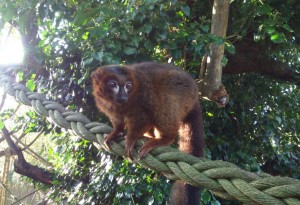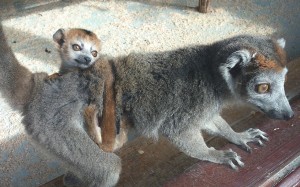
Phil is a volunteer lemur keeper at the Howletts Wild Animal Park in the United Kingdom. He blogs for the Lemur Conservation Network about all things related to lemurs as well as the trials and tribulations of working in captive lemur management. Phil has visited rainforests of Bolivia, Thailand and Sumatra and completed a half-marathon in 2012 for slow lorises. 2015 is Phil’s Year of the Lemur; he will run a half-marathon for greater bamboo lemurs and indris, and then visit Madagascar in June.
I have spent an abnormal amount of time watching and listening to Youtube videos of lemurs and other primates. Where else can you hear an indri sing on demand? However, the site has a startling lack of black lemur videos, along with their unique and amusing grunts. It’s kind of pig-like but more nasal.
So, one sunny Saturday in May last year I set off solo to Howletts Wild Animal Park. Rather than being a ‘zoo’ it has always handled endangered species with the aim of re-introducing them to the wild. I knew black lemurs were in their walk-through. What greeted me at the site though, was a ‘help wanted’ sign.
Would I be happy to spend my weekends watching these prosimians, talking about them, feeding them and cleaning their enclosure? That’s a really stupid question.
A week later then, Youtube had a new black lemur video and I was at Howletts wearing staff uniform. Due to misbehaviour the black lemurs had been moved elsewhere in the park, but under my care would be crowned, red-bellied lemurs and a black and white ruffed after his mate sadly passed away. All are fascinating, quirky species and live happily together. I am greatly privileged to be a small part of their lives.
Introducing Howletts’ Lemurs
We have eight lemurs at Howletts Wild Animal Park. Aramis, the black and white ruffed lemur, is the troublemaker of the bunch.
We have four crowned lemurs, a mum and dad plus their two children. The youngest infant, Ala (Malagasy for Forest) was born in July and is using the cold winter months to hone his fighting skills as he bundles with his big sister. Mum often gets dragged into it, whilst dad is far too cool and mature to be involved in such nonsense. They’re a very close knit unit – where one goes, they all go. They often sleep in a big fluffy pile with their tails wrapped around as scarves.
The red-bellied lemurs are a group of three guys and are a little more reclusive and timid. Their favourite place to rest is atop a large apple tree, away from noisy crowds.
Caring for Howletts’ Lemurs

Howletts’ lemur species are largely frugivorous and so the sweeter the better. Carrots, lettuce and cabbage are mere after thoughts for them. With the park then opened to the public, I meet a manager at the walk-through. Sometimes they have had breakfast, sometimes not. This is where it gets interesting…
Depending on the weather and time of year the three species are fed either indoors or outside. Lemurs are always hungry. Once I’ve checked the perimeter fence it is time to unveil Saturday’s first course and I am mobbed by eight colourful blurs as they jockey for position.
Aramis, our ruffed lemur, is the largest and therefore most forceful with food. He’s also the naughtiest. Having been taught not to jump on your shoulder and throw his head in the bowl, he instead plays tug of war with the bowl and sticks his head in. Although as a ruffed lemur he is supposed to have more exotic (and therefore sweet) fruit, placing of food is an ongoing battle until he’s happy that all of the banana, mango or grapes have gone.

The crowned lemurs have slight dominance over the red-bellies but we make sure that all receive some of the good stuff. When they’re distracted fruit is also placed in enrichment toys so that the animals have to work for their meals, a little like they would in the wild. They also all have interesting and funny ways of eating – they’ll throw their head back as they chew, making sure they catch all the juice.
Once everything containing sugar has been gobbled up it is exploration time. Howletts’ lemurs are very lucky in that they have multiple pear and apple trees plus plenty of quiet places to escape the public if needed. Interestingly their favourite apples are ones which have fallen to the ground and look rotten. Why? They’re sweeter, and beginning to ferment they may even get a little tipsy…
As he is always up to mischief I follow Aramis for much of the day. In return he tries to out-smart me and trick his way into the staff shed. Lunch and dinner are kept there. Like all other ruffed lemurs, he also takes great pleasure in sunbathing, amusing guests with his arms out-stretched and a dazed look in his eye. Without warning he can also break into the trademark black and white ruffed scream, a shrill, haunting bark that marks territory and alerts others of a change in the area. He will very soon have a new girlfriend to scare children with.
How the Lemurs and I Spend our Saturdays
I spend my time teaching guests about primates, Madagascar and conservation. I am soon running a half-marathon for the park’s lemur project, more on that another time… There can also be a lot of manual labour involved. This means weeding, carrying away big bags of apples, and of course mucking out their bedrooms.

Lemurs poo a lot. They are constantly hungry as their bodies fail to take in a lot of a fruit’s nutrients, meaning it takes only ninety minutes to fully digest food and it comes out looking like it went in. It is very easy to tell what breakfast was.
The eight lemurs spend about half the day resting. At current most of this time is spent in their heated bedrooms whilst I apologise to visitors. In warmer temperatures the crowned lemurs spend hours wandering, they’re highly inquisitive and if they’re not sleeping or grooming they’re seemingly searching for something. Their now mature girl is also a wind up merchant and has taught her brother how to pull tails of the other species, or give a playful bite before darting off.
In summer I give talks at lunchtime, often to big crowds. I aim to speak about lemurs in general, too few people are aware of the plight they face at home. I then move on to Howletts’ inhabitants, usually whilst being stalked by Aramis. On one occasion he reduced me to hysterical giggles in front of roughly thirty people. He then started screaming and made a kid cry.
Post-lunch means sleep, before a late afternoon wander. If they’re peckish they return to leftover root vegetables. This is when I have to be most on my toes as all three species are at their most active, running on paths and climbing over heads. Knowing their characters it is also vital that any changes in behaviour are noted. For instance, if a lemur is choosing to be alone rather than join their group.
Bedtime is around 4pm in winter, 5pm in summer. It takes bribery to get them inside, although if they’ve eaten too many apples they can dawdle. On these occasions the whole area is closed to the public so the lemurs have the option of sleeping in a tree or by a radiator indoors. The red-bellies are usually the slowest, you can guess who is fastest to the food bowl.
I then say my goodbyes and wander to the black lemur exhibit, counting down the days until my next shift. Lemurs are truly an animal you can never, ever be bored of.
Take Action
Howletts Wild Animal Park is run by the Aspinall Foundation, a nonprofit member of the Lemur Conservation Network.
